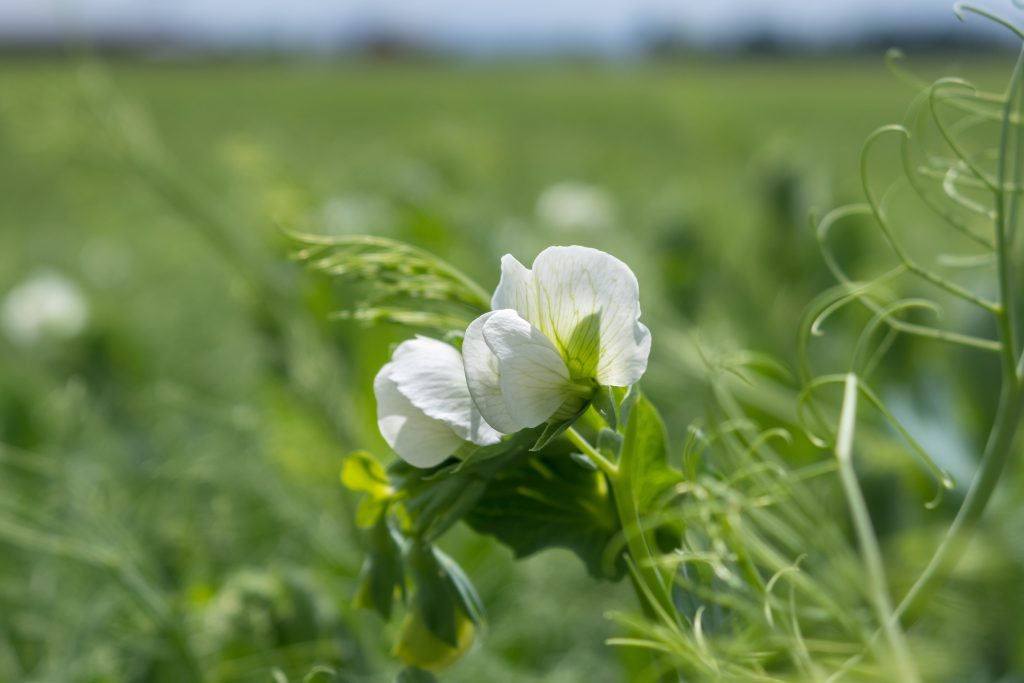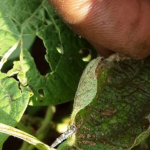The importance of legumes in arable farming
Legumes are of particular importance in arable farming due to their symbiosis with root nodules (rhizobia). The ability of root nodules to fix atmospheric nitrogen makes legumes an important basic component in crop rotations, especially in organic farming. For this reason, legumes are often used not only as the main crop but also as an intercrop, in mixtures or in undersowing. (Gelencsér, Hohmann 2018; Winterling et. al. 2019).
Symptoms and cause of legume fatigue
The problem of intensive legume cultivation
If legumes are used at a high frequency in the crop rotation for several years, yields may gradually or suddenly decrease. Plants may produce less biomass, turn yellow and die almost completely. If neither waterlogging nor nutrient deficiency is the cause of the problem, it is most likely legume fatigue (Gelencsér, Hohmann 2018). It is caused by several diseases and pests that ultimately lead to yield losses and the diagnosis of legume fatigue. These diseases include fungi such as Aphanomyces, Fusarium, Phoma, Rhizoctonia or the oomycete Pytium.
Other factors that can trigger or reinforce legume fatigue are lack of nutrients, inadequate soil structure or damage by animals (e.g. nematodes). It is therefore not a single disease that can be controlled. In forage legumes, for example, clover rot and stem eel can occur. Many diseases are favoured by moisture and lack of oxygen, so soil compaction should be particularly avoided. (Gelencsér, Hohmann 2018; LfL; Serikstad et. al. 2015).

Test for legume fatigue
Legume fatigue should be tested before planning to grow a legume as a main crop, especially in the case of peas and lentils, or if legume fatigue is suspected. The differential diagnosis according to Bouhot and Bonnet (1979) can be used as a quick and simple test to assess whether the soil is prone to legume fatigue.
To perform this test:
- take a mixed soil sample from the suspected area
- sterilise half the sample in an oven at 70 – 100 °C for at least 12 hours
- prepare one pot with sterilised soil and one pot with native soil
- plant peas in both samples
If peas grow much stronger in sterilised soil, this means that legume fatigue is present (Fuchs et. al. 2019).
Check our practical abstract: Test soil for legume fatigue.
Susceptibility of specific species/varieties to the disease
Different legume species are susceptible to legume fatigue to varying degrees. Peas and beans are the most affected. Alfalfa, lupin, red and white clover and vetches can be affected by the same diseases. Cultivation breaks should be observed accordingly (see table below, Gelencsér, Hohmann, 2018).
Large varietal differences were found in the trials. In a trial in Bavaria, for example, the faba bean variety Julia was significantly less susceptible to foot diseases than other varieties. Bean varieties with a high tannin content are less susceptible than varieties with a low tannin content. However, even with more tolerant varieties, the suggested cultivation breaks should be strictly observed. (Gelencsér, Hohmann 2018; Urbatzka et. al. 2015)
Treatment
As legume fatigue is a complex of diseases, pests and soil parameters, direct control is not possible in either conventional or organic farming. In case of observed legume fatigue, a cultivation break of 10 years should be observed on the affected area (Fuchs et. al. 2019).
The use of green waste compost can have a positive effect on the health of peas by revitalising the soil and promoting antagonistic soil flora. This was proven in a trial with peas with a quantity of 10 t/ha (Gelencsér, Hohmann 2018).
Prevention – Avoidance
The development of legume fatigue can be prevented by various cultivation measures.
Cultivation and crop rotation recommendations (Schmidtke 2017, Jakob, I. et. al.)
· Use certified seed. Test self-produced seed for seed-borne diseases.
· Select legume species and varieties that are suitable for the site conditions and less susceptible to fungal root diseases.
· Monitor pH (this is also important for the availability of micronutrients).
· Include organic fertilisation in the crop rotation.
· Create optimal soil conditions: avoid soil compaction
· For peas, take precautionary cultivation breaks of 6 to 9 years.
· Extend the cultivation break to ten years, if there is evidence of heavy infestation with Mycosphaerella pinodes, Aphanomyces or Phoma medicaginis.
· If possible, lupins and vetches should not be grown in a crop rotation with peas.
· Red clover and peas in a rotation are critical because of Phoma medicaginis.
· If peas, especially the white-flowered ones, are to be grown, lucerne is recommended as the main legume crop instead of red clover.
· The combination of lucerne and soybean/lupin in the main crop cultivation also seems to be rather unproblematic.
· On sites not suitable for lucerne, combining red clover and fava bean in a rotation is a viable agronomic option.
· Mixing legumes with non-legumes in the same field has not been proven to lower the build-up of soil-borne pathogens, but ongoing research projects are studying this hypothesis.
· Bitter grain legumes are less sensitive to soil-borne pathogens.
· Use the soilborne pathogen infestation prediction test for field-specific crop rotation planning. (see above: “Test soil for legume fatigue”)
· 40 to 50 % of crop rotation fields without legumes in the main or cover crop of the rotation are necessary.
Cultivation breaks
Appropriate cropping breaks, both within a crop and between different species, are recommended to avoid legume fatigue.
| Crop | Break in years |
| Pea | 6 – 10 |
| Field pea | 5 – 9 |
| Fava bean, lupin, lentil, vetch | 5 – 7 |
| Soybean | 1 – 3 |
| White clover | 1 – 3 |
| Alexandrine clover, Persian clover | 3 – 4 |
| Red clover, lucerne, sainfoin, incarnate clover, Swedish clover, yellow clover | 4 – 7 |
| Grain legume | Forage legumes | Break in years |
| Pea, white flowering | Red clover (lucerne) | 3 – 5 |
| Pea, variegated flowering | Red clover (lucerne) | 2 – 4 |
| Lupin | Red clover (lucerne) | 2 – 4 |
| All grain legumes | White/yellow/spring clover, Serradella | 2 – 4 |
If there is already increased disease or pest pressure in the soil, cultivation breaks should be extended (source: LfL).
Related documents (In German)
· Körnerleguminosen und Bodenfruchtbarkeit, Strategien für einen erfolgreichen Anbau. Link here
· Leguminosen nutzen, Naturverträgliche Anbaumethoden aus der Praxis. Link here
Bibliography
· Bouhot, D., Bonnet, L., 1979. Description et mode d’emploi du test biologique à deux niveaux pour l’étude des fatigues des sols. Annual Review of Phytopathology 11, 111-115.
· Böhm, H., Brandhuber, R., Bruns, Ch., Demmel, M., Finckh, M. R., Fuchs, J., Gronle, A., Hensel, O., Lux, G., Möller, D., Schmidt, H., Schmidtke, K., Spiegel, A., Vogt-Kaute, W., Werren, D., Wilbois, K., Wild, M., Wolf, D., 2014. Körnerleguminosen und Bodenfruchtbarkeit – Strategien für einen erfolgreichen Anbau. Bundesanstalt für Landwirtschaft und Ernährung (BLE), Bonn, Deutschland.
· Freyer, B., Pietsch, G., Hrbek, R., Winter, S., 2005. Futter- und Körnerleguminosen im biologischen Landbau. Österreichischer Agrarverlag, Wien, Österreich
· Fuchs, J., Hohmann, P., Wilbois, K., Conder, M., Gelencsér, T., & Weidmann, G., 2019. Testing soil for legume fatigue (Version 2). Zenodo. https://doi.org/10.5281/zenodo.4421457
· Fuchs J., Clerc, M., Dierauer, H., Hegglin, D., Roggli, M. 2016. Projet KABB 2015: Légumineuses : Prévention de la fatigue des sols. Rapport final. FiBL Schweiz.
· Fuchs J., Bruns C., Mäder P., Schmidt H., Thürig B., Wilbois K., Tamm L., 2013. Differenzialdiagnose: Eine Methode zur Ursacheneingrenzung bei Bodenmüdigkeit. Beiträge zur 12. Wissenschaftstagung Ökologischer Landbau, Bonn, 5. – 8. März 2013, Verlag Dr. Köster, Berlin
· Gelencsér, T., Hohmann, P., 2018. Wenn der Boden müde wird. [When soil gets tired.] UFA-Revue, 2018 (12), S. 34-35.
· Jakob, I., Vogt-Kaute, W.: Leguminosenmüdigkeit. Demonetzwerk Erbse / Bohne. https://www.demoneterbo.agrarpraxisforschung.de/index.php?id=165 abgerufen am 21.03.2022
· LfL (Hrsg.): Fruchtfolgebedingte Krankheiten von Leguminosen im ökologischen Landbau. Bayerische Landesanstalt für Landwirtschaft (LfL), Freising.
· Schmidtke, K., 2016. Neue Strategien der Fruchtfolgeplanung und Düngung bei Leguminosen. Vortrag, Gäa-Wintertagung, 04. und 05.02.2016. HTW, Dresden.
· Schmidtke, K., 2017. Die Abwechslung macht’s. Bauernzeitung, Sonderheft Mai 2017, Ratgeber Ökolandbau 2017, 26-29. Deutscher Bauernverlag, Berlin.
· Serikstad, I. V., De Boer, A., Magnusson, C. (2013): Clover fatigue – a reason for precaution in organic farming. In: LOES, A.K. et al.: Organic farming systems as a driver for change. Bredsten, Denmark.
· Serikstad, G. L.; Magnusson, Ch.; Brodal, G. und de Boer, A., 2015. Searching for the cause of clover fatigue. In: Zeverte-Rivza, Sandija (Hrsg.) Proceedings of the 25th NJF Congress, NJF Latvia, Riga, S. 61-64.
· Urbatzka P., Rehm A., Salzeder G., Jacob I., 2015. Welche Ackerbohne bei Leguminosenmüdigkeit? bioland 1/2015
· Winterling, A., Ostermayr, A., Urbatzka, Dr. P. 2019, Einfluss legumer Zwischenfrüchte auf Körnerleguminosen bezüglich Fruchtfolgekrankheiten. Naturland Ackerbautagung, 23.01.2019, Erdweg
Picture credits:
· Root of Lotus pedunculatus with root nodule: Frank Vincentz Link here
· Pea: Thomas B. on Pixabay: Link here
· Test for legume fatigue: Pierre Hohmann
·············································································································································
·············································································································································
Copyright (c) 2022 The Global Bean Project. This article is protected by copyright.
The Global Bean Project, as the owner of the copyrights or rights of use, reserves all rights.




